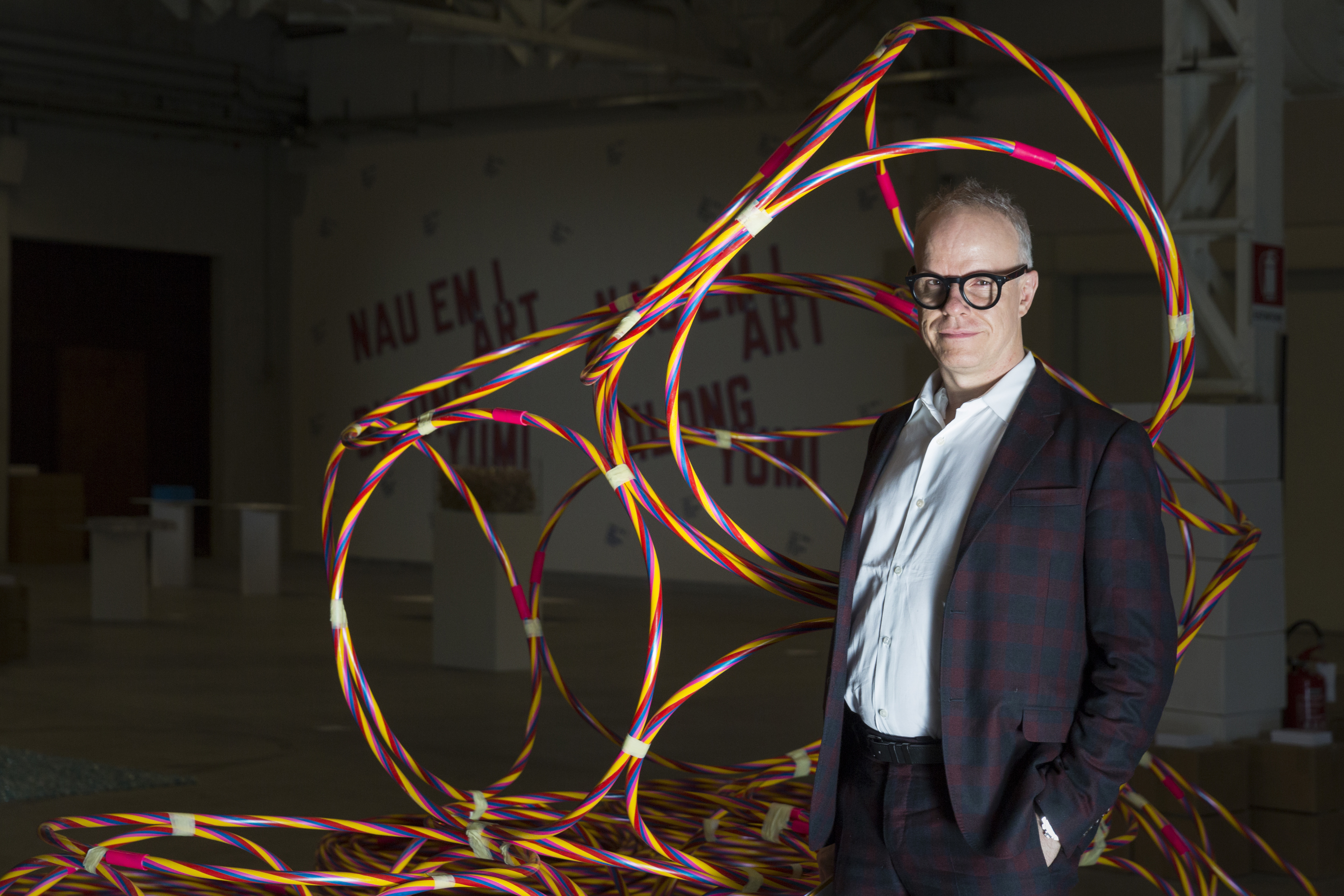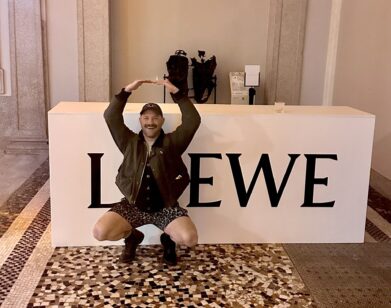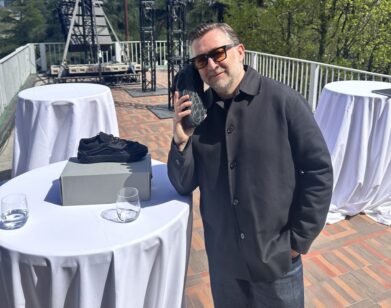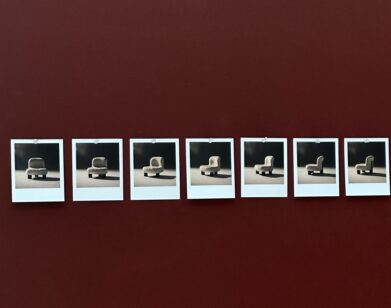A new art show lets you take home a piece from Carsten Höller or Wolfgang Tillmans
These days, you’re lucky if you can take photographs in an art exhibition without a cranky museum attendant barking at you. You’re even luckier if you’re allowed to interact with the art physically or buy some version of it at the museum gift shop. One exhibition, “Take Me (I’m Yours),” now open at Milan’s Pirelli HangarBicocca, allows you to go one step further. Visitors can touch, use, change, eat, wear, and even take home art by 58 artists, including Yoko Ono and Gilbert & George. Some pieces require explicit participation, like drawing, photocopying, or trading a personal item. Others are simply available at a five-finger discount.
This progressive concept was born in the early ’90s from conversations between curator Hans Ulrich Obrist and artist Christian Boltanski about new ways to show art. In 1991, Boltanski shared a piece titled Quai de la Gare—piles of used clothing that visitors could take home in a bag printed with the word “Dispersion.” Obrist and Boltanski debuted the first iteration of “Take Me (I’m Yours)” in 1995 at London’s Serpentine Gallery, and since then, the exhibition has traveled to Paris, Copenhagen, New York, and Buenos Aires. Each version articulates more about art’s power to be interacted with, shared, and used to communicate greater societal values. (Plus, you get to leave with a freebie.)
Now in Milan, with co-curation by Chiara Parisi and Roberta Tenconi, “Take Me (I’m Yours)” includes contributions from a range of Italian and international artists, including Martino Gamper, Pierre Huyghe, Alex Israel, and Francesco Vezzoli. Works by Carsten Höller, Lawrence Weiner, Wolfgang Tillmans, Douglas Gordon, and Gilbert & George reappear from the 1995 exhibition. Contributions from a Ian Cheng and Rachel Rose collaboration, Félix González-Torres’ estate, and Daniel Spoerri involve eating mint candies, sardines, marzipan, and fortune cookies, while Yoko Ono’s Wish Trees usher you through the entrance.
Hans Ulrich Obrist discusses the history of “Take Me (I’m Yours)” and how it’s been adapted for a new audience at Pirelli HangarBicocca in Milan.
CEDAR PASORI: How has “Take Me (I’m Yours)” changed since the original exhibition in 1995?
HANS ULRICH OBRIST: “Take Me (I’m Yours)” actually stopped traveling in the late ’90s. Then two years ago, we revived it, with curator Chiara Parisi, for the Monnaie de Paris. We did a lot of research because a whole new generation of artists had emerged. The younger artists are also working in the digital age, where digital sharing plays a bigger role in context of the work visually.
PASORI: Since then, how have you approached curating each iteration of the exhibition?
OBRIST: For each one, we do a lot of local research. For Paris, we were looking at what happened in France in the ’60s, ’70s, and ’80s. We learned that Daniel Spoerri has been instrumental in the idea of dissemination, and he’s now in his late ’80s, so we added him. We researched the newer generation and added French video artist, Charlie Malgat.
PASORI: What about for the latest “Take Me (I’m Yours)” exhibition at Pirelli HangarBicocca?
OBRIST: For this new exhibition, we did research with curator Roberta Tenconi to decide what the “rules of the game” were—the art of dissemination and dispersion and how it plays a role in Italy. We also found out that, since the ‘60s and ‘70s, Franco Vaccari has been talking about the dissemination of images similar to Hans-Peter Feldmann, focused on how images travel in different circuits. In Vaccari’s installation, visitors can take, print, and leave their selfie on the museum’s walls.
Ugo La Pietra developed a kind of urban plan for the exhibition, one that visitors can use to create their own map of Milan. Francesco Vezzoli is also very interested in this idea of dissemination and creating circuits outside of the art world. He developed a project where people can be drawn with a single tear by a portraitist, which comes from the idea that “art history lacks tears.” At the same time, you have Patrizio Di Massimo, who created a live drawing performance, where the public are actually the ones doing the drawing, and they can either leave what they draw or take it home.
We also have very young artists like Micol Assaël and Rosa Aiello. Or more senior artists like Alberto Garutti, who actually participated in “Take Me (I’m Yours)” in HangarBicocca many years ago. There’s Luigi Ontani, who was already interested in dissemination. There’s Maurizio Cattelan, who is very interested in art for all and going beyond the art world. Maurizio is giving away a copy of a poster he received as a gift from the late artist Alighiero Boetti. Boetti’s influence also appears in a piece by Mario García Torres. We installed a photocopy machine where you can make copies and then take them home.
In the work of Jonathan Horowitz, if you bring an object, you can take an object. One of the younger artists in the exhibition, Riccardo Paratore, who is an emerging Italian artist and a student of Peter Fischli, revisited the context of Albini with a plastic rubber floor from the subway that captures the traces of the visitors.
PASORI: Is there anything about our current moment in time that made you want to do “Take Me (I’m Yours)” in 2017?
OBRIST: It’s a gesture of generosity for our age. We need generosity. This exhibition started at the Serpentine in 1995, and like the HangarBicocca, admission is free. In the context of a society with increasing and devastating inequality, we need to make exhibitions that are truly there for everyone. That’s why free admission is key and comes from a democratic notion of art, the idea of art for all.
It’s also the idea that because people can take away the objects, the exhibition ends up living in many households. If you think about the hundreds or thousands of people who might take a bag full of artwork home, maybe with some prints, little sculptures, or some things they made themselves, they can install these pieces in their houses. The exhibition exists in many places instead of just one institution.
Maybe kids will encounter these pieces, and it will open the door for them to art. Recently I was in Japan, and I was watching television late at night, and there was a Japanese TV series. The backdrop was one of the early posters from “Take Me (I’m Yours).” Miraculously, this piece had transferred that far, over the years, as the art moved around.
PASORI: After seeing the impact and potential of this exhibition yet another time, has “Take Me (I’m Yours)” made you think differently about your role as a curator?
OBRIST: I follow the artists. That’s what Boetti wanted me to do, that’s what Boltanski wants me to do. They say that my job is to make sure art goes beyond the museum, the gallery, or the biennale — contexts where we always expect to see art. If you see art on the subway, in an apartment, or in a kitchen, it will catch you and affect you in a different way.
We try to provide extraordinary experiences for the viewer, and we are always learning. This is one of my favorite exhibitions, and I’m so happy it’s on view next to the Lucio Fontana show, which allows us to create another participatory, immersive experience.
“Take Me (I’m Yours)” is a growing archive. It’s an exhibition that takes away the arrogance of curating or knowing everything. I always believe that exhibitions should reflect our time. They’re like learning systems.
“TAKE ME (I’M YOURS)” IS ON VIEW AT PIRELLI HANGARBICOCCA IN MILAN UNTIL JANUARY 14, 2018.







